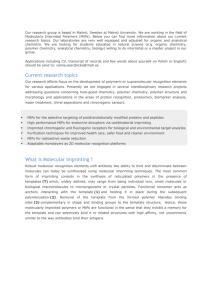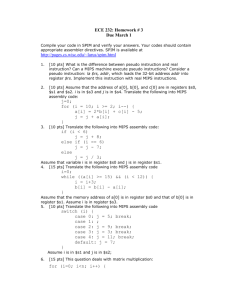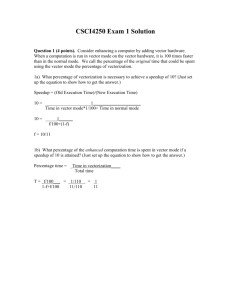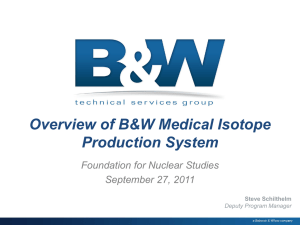Recombinant expression of a functional myo-inositol-1
advertisement
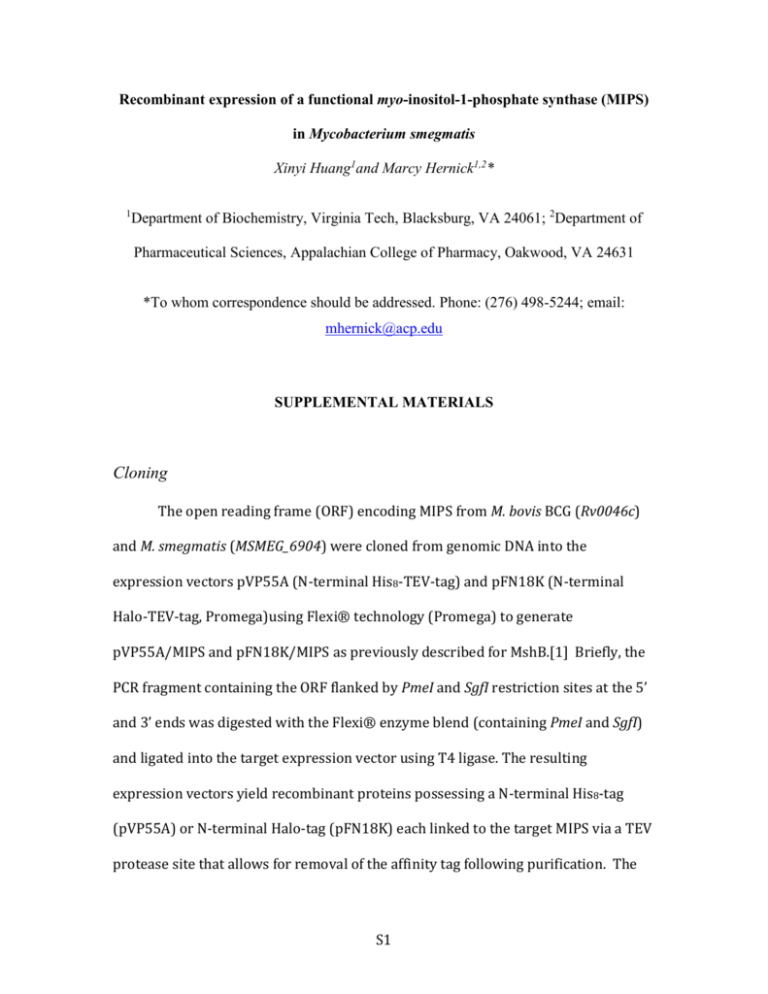
Recombinant expression of a functional myo-inositol-1-phosphate synthase (MIPS) in Mycobacterium smegmatis Xinyi Huang1and Marcy Hernick1,2* 1 Department of Biochemistry, Virginia Tech, Blacksburg, VA 24061; 2Department of Pharmaceutical Sciences, Appalachian College of Pharmacy, Oakwood, VA 24631 *To whom correspondence should be addressed. Phone: (276) 498-5244; email: mhernick@acp.edu SUPPLEMENTAL MATERIALS Cloning The open reading frame (ORF) encoding MIPS from M. bovis BCG (Rv0046c) and M. smegmatis (MSMEG_6904) were cloned from genomic DNA into the expression vectors pVP55A (N-terminal His8-TEV-tag) and pFN18K (N-terminal Halo-TEV-tag, Promega)using Flexi® technology (Promega) to generate pVP55A/MIPS and pFN18K/MIPS as previously described for MshB.[1] Briefly, the PCR fragment containing the ORF flanked by PmeI and SgfI restriction sites at the 5’ and 3’ ends was digested with the Flexi® enzyme blend (containing PmeI and SgfI) and ligated into the target expression vector using T4 ligase. The resulting expression vectors yield recombinant proteins possessing a N-terminal His8-tag (pVP55A) or N-terminal Halo-tag (pFN18K) each linked to the target MIPS via a TEV protease site that allows for removal of the affinity tag following purification. The S1 purified recombinant ino1 proteins from M. bovis BCG and M. smegmatis are termed MtMIPS and MsMIPS, respectively. Recombinant expression of MIPS in E. coli Antibiotics used for recombinant expression in E. coli were: pVP55A/MIPS (ampicillin) and pFN18K/MIPS (kanamycin). Recombinant expression and purification of the target proteins was carried out as previously reported for AtMIPS, MshB, and mycothiol conjugate amidase (MCA).[1-4] Briefly, BL21(DE3) pLysS transformed with pMIPS were grown in LB supplemented with ampicillin (100 g/mL) or kanamycin (50 μg/mL) at 37 °C with shaking (250 rpm) until an OD600 of ~0.6 was reached. Protein expression was induced by the addition of 0.8 mM isopropyl β-D-thiogalactopyranoside (IPTG), and the cells were continued to be shaken at 25 °C for an additional 4 - 6 hours. (Note: Attempts to leave the temperature at 37 °C following the addition of IPTG resulted in a large amount of insoluble protein (inclusion bodies). Therefore, the temperature was reduced to 25 °C after the addition of IPTG to yield more soluble protein.) Cells were harvested by centrifugation and resuspended in either Buffer A (30 mM HEPES, 150 mM NaCl, 0.5 mM imidazole, pH 7.5) for IMAC purification or in Buffer B (30 mM HEPES, 150 mM NaCl, and 1 mM TCEP, pH 7.5) for HaloLinkTM purification. Resuspended cells were lysed using an Emulsiflex-C3 high-pressure homogenizer (Avestin) and the resulting cell lysates were clarified by centrifugation (18,000 rpm, 4 °C). Clarified cell lysates were loaded onto pre-equilibrated affinity columns and purified as described below. S2 Purification of affinity tagged proteins For large-scale protein expression (≥ 1 L), MIPS proteins containing an Nterminal His-tag, or His-Halo-tag, were purified using IMAC protocols previously reported for AtMIPS, MshB, and mycothiol conjugate amidase (MCA).[1-3] Briefly, cell lysates containing His-MIPS were loaded onto a pre-equilibrated Ni-IMAC column (Buffer A: 30 mM HEPES, 150 mM NaCl, 1 mM TCEP, 0.5 mM imidazole, pH 7.5). His-MIPS was eluted using an imidazole gradient step: Buffer A + 10 mM imidazole, Buffer A + 25 mM imidazole, and Buffer A + 250 mM imidazole. The gel shown in Figure S1 depicts fractions from the Ni-IMAC purification of His-MsMIPS. In this example, His-MIPS is eluted from the Ni-IMAC resin using high concentrations of imidazole (Buffer + 250 mM imidazole). Fractions containing the target protein (via 12% SDS-PAGE) were combined, concentrated and dialyzed against 4 L of Buffer A overnight at 4 °C in the presence of His-TEV protease (Slidea-Lyzer, molecular weight cut-off 10,000; Pierce) to remove the His-tag, and loaded onto a second IMAC column (not shown). The resulting protein mixture was loaded to a second pre-equilibrated Ni-IMAC column. In this case, the His-TEV and uncleaved His-MIPS bind to the resin, while the desired un-tagged MIPS is eluted in the flow-through. Fractions containing purified MIPS (via 12% SDS-PAGE) were combined, concentrated, and dialyzed versus 4 L of Buffer A. Protein concentration was determined using the Bradford assay. Protein aliquots were flash frozen in liquid nitrogen and stored at -80 °C. S3 1 2 3 4 5 6 7 8 9 10 11 12 13 14 15 16 17 118 kDa 85 kDa 47 kDa 36 kDa 26 kDa 20 kDa Figure S1. Purification of MsMIPS using Ni-IMAC. Lane 1, MW ladder; Lane 2, His-MIPS purified by DEAE column; Lane 3, loading sample flow through; Lane 4, Buffer A + 0.5 mM imidazole; Lane 5, Buffer A + 10 mM imidazole; Lane 6, Buffer A + 25 mM imidazole; Lanes 7-17, Buffer A + 250 mM imidazole. Small-scale expression (100 mL) of MIPS containing an N-terminal Halo-tag was purified using HaloLinkTM resin (Figure S2) with protocols previously reported for MshB and MCA.[1, 2] Clarified cell lysates were added to 500 μL HaloLinkTM resin (125 μL settled) pre-equilibrated with Buffer B (30 mM HEPES, 150 mM NaCl, and 1 mM TCEP, pH 7.5) in a 1.7-mL Eppendorf tube. After 1 hour, the resin was washed three times with Buffer B (3 x 500 µL) to remove unbound protein, and then resuspended in 250 µL buffer containing TEV protease (5 U/µL). After 1 hour, untagged MIPS was eluted from the resin by centrifugation (13, 200 rpm, 2 min). Protein concentration was determined using the Bradford assay. Protein aliquots were flash frozen in liquid nitrogen and stored at -80 °C. S4 Figure S2. SDS-PAGE of MIPS purification using HaloLinkTM resin. Lane 1, protein ladder. Lane 2 and 5, cell lysates of HisHalo-MIPS (MsMIPS and MtMIPS, respectively). Lane 3 and 6, supernatant after incubation of cell lysates with HaloLinkTM resin (MsMIPS and MtMIPS, respectively). Lane 4 and 7, purified MsMIPS and MtMIPS, respectively. MIPS enzyme activity – periodate assay The MIPS activity of purified proteins was measured using the periodate (stopped-point) assay as previously described.[3, 5] Assay mixtures (100 mM Trisacetate, 2 mM DTT pH 7.5; 20 mM NH4Cl; 1-18 µM MIPS; 300 µM NAD+) were preincubated at 30 °C (1.7 mL microfuge tubes), and the reactions were initiated with the addition of Glc-6-P (0 – 40 mM). Reactions aliquots (30 µL) were quenched at various time points by the addition of 20% trichloroacetic acid (TCA, 10 µL) and precipitated protein was removed by centrifugation. The phosphate group was released from Ins-1P following reaction with an equal volume of 0.2 M NaIO4 and incubation at 37 °C for 1 hour. Excess NaIO4 was removed by the addition of an equal volume of 1 M Na2SO3. The resulting reaction mixture (50 µL) was incubated with 3 M sulfuric acid (10 µL) for 10 min, followed by the addition of H2O (20 µL) and ammonium molybdate (2.5%, 10 µL). After 10 min, 10% ascorbic acid (10 µL) was added to the mixture and it was incubated at 37°C for 1.5 hours. The S5 absorbance value at 820 nm was recorded, and the rate of phosphate production (μM min-1) was calculated from a phosphate standard curve. For experiments examining the effects of additives, the following concentrations were used: 0 - 50 mM ZnSO4 (ZnCl2, Zn-acetate), 0 - 50 mM MnCl2, 0 – 50 mM CoCl2, 0 – 1 mM EDTA, 0 - 40 mM NH4Cl, or 0-20% glycerol. Relative rates of phosphate production correspond to the rate of phosphate production (μM min-1) per 1 μM MIPS. Specific activity measurements were determined by dividing the observed rate of phosphate production (μM min-1) by the amount (mg) of protein used in the assay. S6 NAD+-Binding Assay The affinity of NAD+ for MIPS was measured by monitoring the decrease of intrinsic MIPS fluorescence intensity upon NAD+ binding.[6, 7] Results for NAD+ binding to MIPS from Archaeoglobus fulgidus (KD = 1.1 ± 0.4 µM) and Arabadopsis thaliana (KD = 0.24 ± 0.06 µM) are shown in Figure S3. The apparent KD value for AfMIPS (1.1 ± 0.4 µM) is within error to the previously published value of 1 ± 0.2 µM [6] and KMNAD+ of ~ 5 µM [7], while the KD value for AfMIPS is comparable to the reported KMNAD+ of 0.46 ± 0.1 µM.[5] A B Figure S3. NAD+ binding to MIPS from Archaeoglobus fulgidus and Arabadopsis thaliana. (A) NAD+ binding to AfMIPS. NAD+ (0 - 20 µM) was added to a solution of AfMIPS (1 μM) in buffer (50 mM MOPS, 1 mM TCEP, pH 7; 400 μM EDTA; 10 mM NH4Cl; 10% glycerol; total volume 100 μL). The fluorescence signal of the enzyme mixture (Excitation wavelength = 280 nm, Emission wavelength = 334 nm) was recorded and processed as described in Materials and Methods. (B) NAD+ binding to AtMIPS. NAD+ (0 - 15 µM) was added to a solution of AtMIPS (3 μM) in buffer (50 mM MOPS, 1 mM TCEP, pH 7; 400 μM EDTA; 10 mM NH4Cl; 10% glycerol; total volume 100 μL). The fluorescence signal of the enzyme mixture (Excitation wavelength = 280 nm, Emission wavelength = 334 nm) was recorded and processed as described in Materials and Methods. S7 Gel filtration The solution molecular weight of purified MIPS proteins were determined using size exclusion chromatography using a Superdex 200 10/300 GL column.[8] Enzyme Peak 1 (Da) Peak 2 (Da) MsMIPS 143,904 -- (E.coli) 135,187 -- MtMIPS 283,599 44,791 (M.smegmatis) 248,058 37,384 Figure S4. Solution molecular weight of MIPS (50 mM sodium phosphate, 150 mM NaCl, pH 7.5) as determined using size exclusion chromatography as described in “Materials and Methods”. Elution profile of MIPS expressed in E. coli (blue line) and M. smegmatis (red line). The dashed line crossing the first peak in both elution profiles represents the Dextran 2000. The elution volume for aprotinin, ovalbumin, and conalbumin were used to calculate the Kav values (Kav = (Ve-V0)/(Vt-V0), where V0 is the void volume of the column, Vt is the total volume of the column, and Ve is the elution volume of the protein.) and molecular weights of the unknown protein samples. The numbers in the table depict the values obtained from each sample (run in duplicate). S8 Sequence Alignment Figure S5. Sequence alignment of MIPS proteins from A. fulgidus (O28480), M. tuberculosis (P9WKI1), M. smegmatis (A0R7G6), and S. cerevisiae (P11986) using ExPASy. ‘*’ identical residues in all sequences; ‘:’ conserved substitutions; ‘.’ semiconserved substitutions. MIPS Structures S9 Figure S6. MIPS tetramer (PDB 3QVT). Residues corresponding to MtMIPS 242-267 are highlighted in pink. Figure S7. (A) AfMIPS (PDB 3QVT) in orientation 1. (B) ScMIPS (PDB 1P1J) in orientation 1. (C) AfMIPS (PDB 3QVT) in orientation 2. (D) ScMIPS (PDB 1P1J) in orientation 2. S10 Figure S8. Ligands in overlay of MtMIPS (PDB 1GR0, purple), AfMIPS (PDB 3QVT, tan), and ScMIPS (PDB 1P1J, green) in orientation 2. References: 1. Huang, X., Kocabas, E., Hernick, M. (2011) The activity and cofactor preferences of N-acetyl-1-D-myo-inositol-2-amino-2-deoxy-Œ±-Dglucopyranoside deacetylase (MshB) change depending on environmental conditions. J. Biol. Chem. 286: 20275-20282 2. Kocabas, E., Liu, H., Hernick, M. (2015) Identity of cofactor bound to mycothiol conjugate amidase (Mca) influenced by expression and purification conditions. Biometals 28: 755-763 3. Huang, X., Hernick, M. (2011) A limitation of the continuous spectrophotometric assay for the measurement of myo-inositol-1-phosphate synthase activity. Anal. Biochem. 417: 228-232 4. Huang, X., Hernick, M. (2011) A fluorescence-based assay for measuring Nacetyl-1-D-myo-inosityl-2-amino-2-deoxy-α-D-glucopyranoside deacetylase (MshB) activity. Anal. Biochem. 414: 278-281 5. Donahue, J.L., Alford, S.R., Torabinejad, J., Kerwin, R.E., Nourbakhsh, A., Ray, W.K., et al. (2010) The Arabidopsis thaliana Myo-Inositol 1-Phosphate Synthase1 Gene Is Required for Myo-inositol Synthesis and Suppression of Cell Death. The Plant Cell Online 22: 888-903 6. Neelon, K., Wang, Y., Stec, B., Roberts, M.F. (2005) Probing the Mechanism of the Archaeoglobus fulgidus Inositol-1-phosphate Synthase. J. Biol. Chem. 280: 11475-11482 S11 7. 8. Chen, L., Zhou, C., Yang, H., Roberts, M.F. (2000) Inositol-1-phosphate Synthase from Archaeoglobus fulgidus Is a Class II Aldolase. Biochemistry 39: 12415-12423 Andrews, P. (1964) Estimation of the molecular weights of proteins by Sephadex gel-filtration. Biochem. J. 91: 222-233 S12

